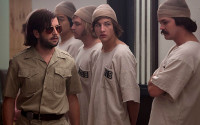| SHADOWS ON THE WALL | REVIEWS | NEWS | FESTIVAL | AWARDS | Q&A | ABOUT | TALKBACK | |||
| The Stanford Prison Experiment | |||

| |||
|
dir Kyle Patrick Alvarez scr Tim Talbott prd Brent Emery, Lizzie Friedman, Karen Lauder, Greg Little, Lauren Bratman with Billy Crudup, Ezra Miller, Michael Angarano, Tye Sheridan, Olivia Thirlby, James Wolk, Nelsan Ellis, Thomas Mann, Johnny Simmons, Nicholas Braun, Keir Gilchrist, Jack Kilmer release US 17.Jul.15, UK 10.Jun.16 15/US 2h02  Extreme role-play: Angarano, Sheridan and Simmons 


SUNDANCE FILM FEST  |
R E V I E W B Y R I C H C L I N E | ||
 True events from 1971 California are dramatised in this cleverly made film, which turns suddenly from breezy comedy into a horrific thriller that explores the darkest corners of a normal person's psyche. As it shifts, the film begins to feel overlong and increasingly hard to take. But what's really scary is how it demonstrates that this awful experiment proved something important.
True events from 1971 California are dramatised in this cleverly made film, which turns suddenly from breezy comedy into a horrific thriller that explores the darkest corners of a normal person's psyche. As it shifts, the film begins to feel overlong and increasingly hard to take. But what's really scary is how it demonstrates that this awful experiment proved something important.
Responding to a newspaper ad, 24 university students are divided at random to play prisoners and guards in a role-playing psychological experiment coordinated by Dr Zimbardo (Crudup). What begins with a jokey atmosphere quickly reveals issues of control and vulnerability. Playing a guard, Christopher (Angarano) takes his role far too seriously, sadistically humiliating the prisoners, starting with 8612 (Miller) and 819 (Sheridan). And when the inmates revolt, the situation gets even more intense. Zimbardo and his colleagues decide to let it continue, but his girlfriend/colleague Christina (Thirlby) has strong doubts. Aside from Angarano's Buford T Justice accent, the fine young actors nicely underplay their characters, with the guards hiding behind their sunglasses and the prisoners naked under sackcloth dresses. These characters' different styles of youthful energy and attitude are bracingly realistic. So it's easy to see the inner workings of these guys' minds as things spiral in unexpected directions. With bare sets, the film is shot and edited in a sober style that feels almost documentary. Director Alvarez carefully controls scenes to allow the viewer to experience both the guards' and prisoners' perspectives. So the flaws and unexpected strengths of Zimbardo's set-up are obvious from the start. The plan is to examine the impact of institutionalisation, but the real revelation is in the abuse of power. Of course, the film offers yet another layer of behavioural study in the reactions of those who are running the experiment and let the guards' abuse continue. With all of this flaring machismo, it's not surprising that it took a woman to stop it. Like the film audience, Zimbardo's team seems to find the mayhem rather entertaining, even as things turn increasingly grim. The movie sometimes seems a bit repetitive as it tries to craft a plot structure from a real event. But what's depicted has such resonance in news headlines that it can't help but leave audiences deeply shaken. Basically, the experiment predicted Abu Ghraib in frightening detail, which was the basis for the real Zimbardo's 2007 book The Lucifer Effect.
| |||
| R E A D E R R E V I E W S | |||

 Still waiting for your comments ... don't be shy.
Still waiting for your comments ... don't be shy.
| |||
|
© 2016 by Rich Cline, Shadows on the Wall HOME | REVIEWS | NEWS | FESTIVAL | AWARDS | Q&A | ABOUT | TALKBACK | |||
